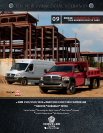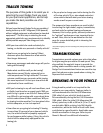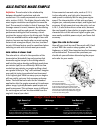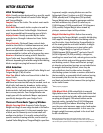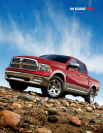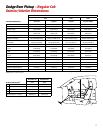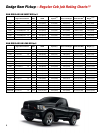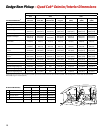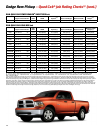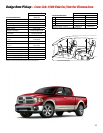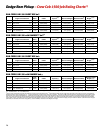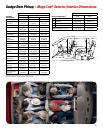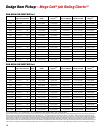5
HITCH SELECTION
Hitch Terminology
Hitch: Usually custom-designed for a specic model
of towing vehicle. Rated for Loaded Trailer Weight
and Tongue Weight.
Coupler: Part of the trailer. The socket must match
the ball size.
Hitch Ball: Must match trailer coupler size and be
rated to handle Gross Trailer Weight. Attachment
must be compatible with mounting area of hitch.
Safety Chains: Usually provided by the trailer
manufacturer. Strength is based on Gross Trailer
Weight.
Sway Controls: (Optional) Sway controls help
minimize the effects of sudden manoeuvres, wind
gusts, and buffeting caused by other vehicles.
Some are adjustable for varying conditions –
recommended for trailers with a large surface area.
Receiver: Attaches to towing vehicle. Rated for
Gross Trailer and Tongue Weights. Ratings may be
different depending on whether weight-distributing
hitch or weight carrying ball mount is used.
Hitch Selection
Step One: Determine the Loaded Trailer Weight and
Tongue Weight (TW) of trailer.
Step Two: Match trailer and tow vehicle to find the
correct hitch.
Step Three: Choose the right hitch, as well as
additional accessories that may be needed, such as
hitch balls, ball mounts, drawbars, trailer wiring,
safety chains, transmission coolers, locks, trailer
brake controls, ball and receiver tube covers, tow
bars or sway controls. Your Dodge Retailer can
supply you with the authentic Mopar
®
equipment
specifically designed for your Dodge Truck.
There are Three Basic Types of Hitches:
Weight-Carrying Hitch: Supports Trailer Tongue
Weight as though it were cargo located at the ball or
other connecting point. It is the most popular type
of hitch, and is commonly used to tow small and
medium-size trailers. It is usually custom built for
specific models of towing vehicles, and is rated by
Loaded Trailer Weight and Tongue Weight capacities.
In general, weight-carrying hitches are used for
lightweight (Class I) trailers up to 907 kilograms
(2000 pounds) and 91 kilograms (200 pounds)
Tongue Weight when towed by passenger vehicles
and with medium-duty (Class II) trailers up to
1588 kilograms (3500 pounds) and 159 kilograms
(350 pounds) Tongue Weight when towed by
pickups, vans and sport utility vehicles.
Weight-Distributing Hitch: Rather than merely
supporting the Tongue Weight, a weight-distributing
hitch applies leverage between the towing vehicle
and the trailer, thus distributing Tongue Weight to
all the towing vehicle and trailer wheels. A weight-
distributing hitch allows you to tow trailers with
greater Tongue Weights, typically in Class III
(2268 kilograms [5000 pounds])
(1)
and up to Class IV
(4536 kilograms [10,000 pounds])
(1)
categories,
resulting in a more level ride, reducing stress on the
rear of the vehicle and providing greater steering
and braking control. Please note that air springs,
air shocks and overload springs are not substitutes
for weight-distributing hitches, since they do
not redistribute load to other axles. A weight-
distributing system includes a receiver attached to
the tow vehicle, a removable hitch head and spring-
bar assembly that fits into the receiver opening,
and hook-up brackets that connect the spring bars
to the trailer frame.
(1)
When properly equipped.
Fifth-Wheel Hitch: A fth-wheel hitch is a special
high platform over the rear axle of the tow vehicle that
connects a vehicle and a trailer with a trailer-mounted
coupling pin (kingpin). Fifth-wheel trailers are the
heaviest variety, typically Class IV (4536 kilograms
[10,000 pounds]) and above. Mounting the hitch
over the rear axle improves sway control and makes
long trailers more manoeuvrable. In this case, the
kingpin weight becomes payload in the truck bed
for all calculations.
NOTE: Trailer Tow Group does not include the hitch shank or ball.
Your Dodge Retailer can supply you with the correct hitch set-up at extra
cost to meet your specific needs and arrange to have it installed for you.



